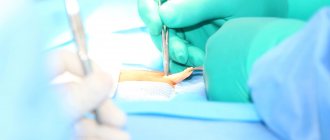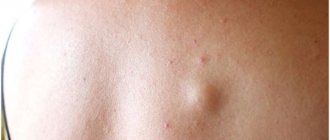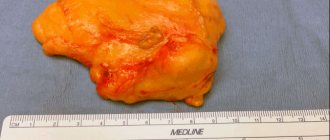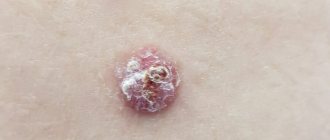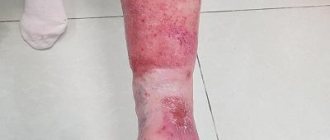An umbilical hernia appears as a protrusion in the navel area that disappears or decreases in size when you lie down.
An umbilical hernia may be accompanied by discomfort, abdominal pain, and nausea.
The main cause of this disease is the weakening of the umbilical ring and the formation of a hole in the anterior abdominal wall, through which internal organs (intestines, greater omentum) emerge under the skin.
An umbilical hernia develops more often in women, which is associated with stretching of the umbilical ring during pregnancy.
Other causes of umbilical hernia include heavy lifting, chronic constipation, and obesity.
How do hernias form?
Hernias occur in the area of “weak spots” of the anterior abdominal wall, under the influence of intra-abdominal pressure. Factors that cause its increase are called producing factors and include: physical activity, cough, childbirth and all those cases when the abdominal press tenses.
“Weak spot” is the area of the abdominal wall where the muscular aponeurotic part is most thinned. This may be the place of muscle attachment to the aponeurosis or physiological openings (inguinal rings, umbilical ring).
An increased risk of hernias is observed in people with predisposing factors: connective tissue weakness syndrome, damage to the nerves innervating the abdominal wall, as well as the presence of postoperative scars.
Rehabilitation after surgery
The recovery period can last 1-1.5 months. All this time you need to wear a special bandage.
- After the operation, the patient is under the supervision of a doctor. You can't get up during the first hours. The pain is relieved with an anesthetic drug, and an antibiotic is also prescribed.
- If abdominal surgery was performed, you cannot get up for two days.
- In the first week, regular dressings are performed.
- For two weeks, any physical activity, even light, is excluded. Even a cough can negatively affect the condition of the seam.
- You should start eating with liquid food, then steamed meat and fish, cereals, fruits and vegetables are introduced into the diet.
- After complete formation of the postoperative scar, exercise therapy is recommended to strengthen the back, abdomen, and thighs. Exercises are selected by the attending physician. Classes are held with a bandage on the stomach.
Subsequently, you should not lift weights or engage in intense sports. Nordic walking, walking, and light jogging are useful.
What does a hernia consist of?
All hernias, regardless of location and size, have a common structure and consist of the following components:
- A hernial orifice is a defect of the anterior abdominal wall, mainly in the aponeurosis. Through them, the internal organs leave the abdomen and end up under the skin. If the hernial orifice is wide, then through it the contents can freely return to the abdominal cavity.
- Hernial sac is a sheet of stretched peritoneum covering organs that extend beyond the abdominal cavity through the hernial orifice. The hernial sac is covered with several membranes, these also include subcutaneous tissue and skin.
- The contents of the hernial sac are the internal organs or their individual parts that extend beyond the abdominal cavity through the hernial orifice.
Do you want to get rid of a hernia quickly and permanently?
You're lucky to have found us. Contact us for advice.
- We will conduct an in-depth diagnosis of the condition of your abdominal cavity
- We will select for you the optimal treatment method from the entire range of modern high-tech surgical techniques
- Our highly qualified specialists - candidates and doctors of medical sciences - will perform the operation using the latest technologies, expensive specialized equipment and materials
- Your stomach will become healthy and beautiful, and traces of the intervention will be completely invisible to prying eyes
- We will carry out follow-up examinations and monitor your abdominal condition for six months to ensure there is no recurrence (free of charge)
What types of hernias are there?
Depending on the anatomical location, external and internal hernias are distinguished. External ones include:
- Umbilical hernia.
- Inguinal hernia.
- Hernia of the white line of the abdomen.
- Postoperative hernia.
- Paracolostomy hernia.
- Lumbar hernia.
- Perineal hernia.
- Obturator hernia.
- Hernia of the xiphoid process.
- Sciatic hernia.
Hernias that form inside the abdominal cavity are considered separately. With such hernias, internal organs can be located in pockets of the peritoneum or penetrate into the chest cavity through the openings of the diaphragm.
Depending on the size of the hernia, they are divided into:
- Small: hernial orifice less than 4 cm
- Medium: hernial orifice from 4 to 10 cm
- Large: hernial orifice larger than 10 cm
Hernias are also classified according to the degree of development:
- initial - a small depression is identified in a weak spot of the abdominal wall - a triggering factor for the formation of a hernia;
- canal - internal organs begin to sink into the hernial opening;
- complete - the internal organs have passed through the hernial orifice and are located under the skin.
According to the clinical course, hernias are divided into:
- reducible - the contents of the hernial sac move freely from the abdominal cavity to the hernial sac and back.
- irredeemable.
- strangulated - a condition in which the hernial orifice puts pressure on the structures of the released organ, which leads to disruption of its blood supply and can lead to necrosis. There are: elastic strangulation, fecal strangulation, parietal strangulation, retrograde strangulation, Meckel's diverticulum strangulation, Broca's hernia.
What are the symptoms of a hernia?
In the initial stages, a hernia may manifest itself as discomfort or slight pain during physical activity at the site of hernia formation. As the aponeurosis thins or the tissues of the anterior abdominal wall weaken, a painless protrusion appears, disappearing when pressure is applied to it. With each new episode of increased intra-abdominal pressure, the hernial orifice will increase in size, and the sac will stretch due to an increase in the volume of contents.
External abdominal hernias that occur without complications are characterized by such general symptoms as: the presence of a hernial protrusion, discomfort in the hernia area, dysfunction of the organs that make up the hernial contents.
Why is a hernia dangerous?
Any hernia is dangerous for the development of complications. The most serious complication of a hernia is strangulation. It occurs when the blood supply to the contents of the hernial sac is disrupted and tissue necrosis occurs.
An equally serious complication is intestinal obstruction. As a result of the prolonged presence of intestinal loops inside the hernial sac, they are compressed, the movement of intestinal contents through them is disrupted, and intestinal obstruction forms.
It is very important to understand that the development of complications can occur suddenly, against the background of complete well-being: on vacation, at the dacha, while traveling - in situations where qualified medical care is difficult to access or not available at all. Treatment of hernia complications requires emergency intervention, and delay can lead to a sharp deterioration in a person’s condition and significantly worsen the prognosis of delayed treatment.
Therefore, it is better to get rid of the hernia before complications develop.
Hernia treatment
It is only possible to completely get rid of a hernia through surgery. There are also conservative methods to alleviate the condition of a hernia, but their use is possible only if there are contraindications to surgery.
Contraindications to elective surgical treatment include severe concomitant diseases, malignant processes in advanced stages, acute diseases and pregnancy. It is important to note that complicated hernias must be operated on urgently for health reasons.
The smaller the size of the hernia, the easier the operation for both the surgeon and the patient. In turn, the treatment of giant hernias represents a major surgical problem and requires the use of non-standard approaches to its elimination.
Hernioplasty (hernia repair) is the name of an operation to “liquidate” a hernia with plastic surgery of a defect in the anterior abdominal wall.
Are there non-surgical methods for treating umbilical hernia?
The only way to remove an umbilical hernia is surgery. It is impossible to “set” a hernia once and for all without surgery.
The use of bandages in this situation also does not allow for a cure.
The use of new technologies, the use of modern plastic and suture materials, and many years of experience of our surgeons guarantee the highest quality of operations to remove an umbilical hernia, the absence of postoperative complications and relapse (recurrence of the disease).
What are the methods of anterior abdominal wall plastic surgery?
Plastic methods can be tension or non-tension.
Tension is a type of plastic surgery performed using the patient’s own tissues. This method received this name because, in order to eliminate a hernia defect, the tissues must be “tightened” and sewn together. The resulting tension in the tissues can cause pain after surgery and result in a possible relapse. At the present stage of development of medicine, this method of closing hernias defects is significantly inferior to non-tension methods.
Tension-free plastic surgery involves the use of modern mesh prostheses to strengthen the anterior abdominal wall. The prosthesis is a polypropylene network, which, due to its flexibility, strength and high degree of tissue “germination”, has shown its reliability and safety when used in hernia repair. Mesh prostheses come in different sizes, from small ones with a diameter of 5 cm for umbilical hernias, to large ones of 50 x 50 cm for giant incisional hernias. Modern three-dimensional mesh systems make it possible not only to strengthen the hernia defect in the form of a “patch”, but to completely fill it, significantly reducing the risk of relapse. In some situations, a special mesh is installed, the surface of which is coated with a special composition that allows it to safely contact the abdominal organs and avoid the formation of adhesions between them.
The open hernia repair operation consists of several stages:
- Isolation of the hernial sac. A skin incision is made above the hernial protrusion, the hernial sac is freed from the surrounding subcutaneous fatty tissue. The “hernial orifice” is distinguished.
- The hernial sac is opened, the condition of the contents of the hernial sac is assessed, and if there are no complications, the contents are immersed in the abdominal cavity.
- The hernial sac is excised, stitched and plunged into the abdominal cavity.
- The integrity of the anterior abdominal wall is restored (plasty is performed).
Umbilical hernia in adults - symptoms and treatment
Treatment of umbilical hernia in adults is only surgical. Even an uncomplicated hernia is an indication for surgery [9]. It is impossible to cure a hernia with bandages; as a rule, they are used after surgery as part of rehabilitation.
Goals of surgical treatment:
- Return the contents of the hernial sac to the abdominal cavity or remove it if the areas of the strangulated organs are no longer viable.
- Restore the integrity of the abdominal wall in the area of the hernia defect, including using mesh prostheses. Such prostheses help to further strengthen the abdominal wall in the scar area. Connective tissue cells grow into the cells of the mesh and due to this, a dense scar “shell” is formed in the scar area, which prevents recurrence of the hernia.
The operation can be performed either open or laparoscopic. Both methods are equally effective, but after laparoscopy the pain syndrome is less pronounced and the patient’s rehabilitation is faster [1][9].
For small hernial protrusions (up to 1–2 cm), open surgery is often performed with local anesthesia. The surgeon makes an incision in the projection of the umbilical ring, places the organs and tissues from the hernial sac into the abdominal cavity and sutures the tissue to restore the integrity of the abdominal wall. Additionally, the weak area is strengthened with a mesh endoprosthesis. The mesh implant can be located preperitoneally (above the peritoneum), retromuscularly (behind the rectus abdominis muscles), supraponeurotically (between the aponeurosis and subcutaneous fatty tissue), or otherwise. The installation location depends on the technique. With open surgery with local anesthesia, the rehabilitation period is 1–2 weeks.
Laparoscopic surgery is considered a minimally invasive surgical procedure. It is performed using a video camera and special tools. The surgeon sees the surgical field on the monitor and controls all his actions during the operation. With laparoscopy, the period of hospital stay is reduced to 2–3 days.
For large hernias, most often only open surgery under endotracheal (general) anesthesia is possible. The surgeon makes a long incision in the abdomen, isolates the hernial sac, places the organs and tissues from the hernial sac into the abdominal cavity, removes the excess walls of the hernial sac and then sutures the tissues. If the hernial orifice is more than 2 cm, a mesh prosthesis is always installed. After such an operation, the patient remains in the department from 1–2 days to a week.
When operating on a strangulated hernia, the surgeon first carefully examines the contents of the hernial sac and determines its viability. If the contents of a strangulated hernia are reduced into the abdominal cavity before the doctor makes an incision, then it is necessary to examine the contents of the abdomen, find the strangulated organs and assess their condition. If the intestinal wall becomes necrotic or perforated (ruptured), the affected part of the organ is removed. After this, the surgeon sutures the hernial orifice. A mesh implant is not placed due to the high risk of wound suppuration and mesh rejection. It can be installed later, when the inflammation subsides or the hernia appears again.
When the contents of the hernia are suppurated (phlegmon of the hernial sac), an incision in the abdomen is usually made not above the hernia, but a little further. After this, the contents of the sac are isolated: the strangulated intestine is excised, the area of the hernial orifice is sutured from the side of the abdominal wall. At the next stage, the surgeon removes the hernial sac with its contents or opens the hernia and washes the cavity of pus and dead tissue. A mesh implant is not installed for this complication. It can be installed later, when the inflammation subsides or the hernia appears again.
If the strangulated hernia has repaired itself before the patient is taken to the operating room, it is necessary to monitor the patient for 24 hours to make sure that there is no necrosis of the strangulated organs and peritonitis. If the patient feels well and there are no signs of peritonitis, it is recommended to undergo elective surgery to remove the hernia.
Rehabilitation after hernia removal
In order for the patient to recover after surgery as quickly as possible, it is recommended that he:
- do not lift weights exceeding 5 kg in the first 5–6 weeks after surgery;
- gradually increase physical activity: 14 days after surgery, swimming, light jogging, walking, Nordic walking, cardio training without straining are allowed;
- treat concomitant diseases, especially diabetes mellitus and chronic obstructive pulmonary disease;
- wear a postoperative bandage for two months;
- control weight.
Possible complications of operations
Complications can arise with any operation on the abdominal organs; this is due to the technique of execution [1][9]. Such complications include:
- Injury to the intestinal wall during surgery. If such a complication occurs, the intestinal defect must be immediately sutured.
- Bleeding in the postoperative period with the development of a hematoma of the surgical wound or inside the abdomen. It may be associated not only with a violation of the surgical technique, but also with a violation of the patient’s coagulation system, for example, with hemophilia. This complication does not always require a second operation: if there are no signs of ongoing bleeding (increasing hematoma, increasing pallor and general weakness, bleeding from the wound), you can evacuate the hematoma or perform a puncture of the abdominal cavity. If bleeding continues, the blood vessel is sutured or cauterized.
- Seroma of a postoperative wound. This is an accumulation of serous fluid at the site of the removed hernial sac. It manifests itself as swelling and compaction in the wound area. If a seroma develops, the surgeon evacuates the fluid in the dressing room; repeated surgery is not required.
- Suppuration of a postoperative wound. It manifests itself as redness in the wound area, throbbing pain in the wound, as well as an increase in body temperature. If suppuration occurs, it is necessary to remove pus from the wound and prescribe antibiotic therapy. It is often necessary to remove the mesh implant.
- Chronic pain syndrome . It manifests itself in the fact that the patient has been bothered by pain in the area of the postoperative wound for a long time (more than two months). The cause of the complication is damage to the nerve structures during surgery. Chronic pain syndrome requires an integrated approach. Sometimes it is necessary to perform a second operation to free the nerve from the compressing tissue or remove the mesh implant [6].
- Displacement of the mesh implant. The endoprosthesis may move if the mesh fixing material (suture material or clips of various modifications) comes off. In this case, the implant moves to the lower corner of the wound and folds, which often leads to recurrence of the hernia and the need for repeated surgery.
- Recurrence of hernia. It occurs for various reasons: due to the characteristics of the patient’s connective tissue, suppuration of the implant, wound healing by secondary intention, or violation of the surgical technique. In case of relapse, the hernia is removed using a different method, i.e. if a relapse occurs after open surgical treatment, then it is recommended to perform a repeat operation using the laparoscopic method and vice versa.
Treatment of umbilical hernia in pregnant women
There are no generally accepted clinical recommendations for the treatment of hernias in pregnant women, but three key points can be identified:
- strangulated hernias in pregnant women require emergency surgical treatment;
- asymptomatic hernias up to 3 cm are recommended to be operated on after childbirth or in the second trimester of pregnancy;
- preference is given to the laparoscopic method, but the decision on the volume of intervention should be made with the participation of an experienced obstetrician-gynecologist [14].
Is it possible to operate a hernia without incisions using modern mesh prostheses?
Yes, you can!
At the moment, laparoscopic hernioplasty is the operation of choice for the treatment of various types of hernias. This operation is performed through punctures in the anterior abdominal wall. The surgeon inserts a video camera into the abdominal cavity and, using additionally inserted manipulators, releases the hernial sac from its contents. In the second stage, the surgeon separates the peritoneum of the hernial sac from the tissues of the anterior abdominal wall, dissects it and places a special mesh prosthesis on the hernial orifice. Then, the mesh is reinforced on top with the previously separated peritoneum.
Thanks to this, the prosthesis does not form adhesions with internal organs. This method of plastic surgery avoids tissue tension and greatly reduces the likelihood of relapse. The absence of large incisions on the anterior abdominal wall contributes to a comfortable course of the postoperative period.
What is the most effective method for removing an umbilical hernia?
Our surgeons are fluent in endoscopic technology, but this technique is not always applicable for complex hernias. Often, much better results can be achieved by open hernioplasty.
Based on many years of experience in hernia repair, our surgeon will choose the optimal access method based on the characteristics of your particular disease.
The main factor in the successful outcome of hernia surgery is its impeccable technical execution. Poor surgical technique can ruin any method, even the best one. If all stages of the operation are performed correctly, then with any type of access the probability of hernia recurrence is minimal.
How does the postoperative period proceed?
After laparoscopic hernia repair, pain is practically not felt and is therefore easily controlled using tablet painkillers.
The only reminder of the operation was discomfort in the area of small punctures on the anterior abdominal wall.
In uncomplicated cases, discharge from the hospital occurs within 2-3 days. The time frame for returning to work, on average, does not exceed 10-14 days.
Traditional open surgery is characterized by pain in the postoperative period. However, carrying out comprehensive pain relief in a hospital allows you to reduce its severity and feel comfortable throughout the entire recovery period.
After discharge from the hospital, you will be advised to limit physical activity for a period determined by your attending physician based on the complexity of the treatment performed.
Umbilical hernia rehabilitation
Immediately after the operation, an elastic bandage is put on, which must be worn for a month.
At the BEAUTY DOCTOR clinic, patients are accommodated in single and double comfortable rooms.
The wards are equipped with continuous monitoring systems to monitor the patient's condition after surgery. Multifunctional beds create the opportunity to position and feed the patient after surgery in the most convenient position for him.
Each patient is provided with individual nursing care.
Since we use minimally invasive and maximally gentle techniques when repairing umbilical hernias, the postoperative period is easy and without any special complications.
You can get out of bed on the day of surgery. The next day after the operation, the patient goes home on his own, and after another 8-9 days comes for a follow-up examination and removal of sutures.
Two weeks after surgery, you are allowed to resume moderate physical activity (running, brisk walking). After endoscopic hernioplasty, such loads can be resumed within a few days.
A month after the operation, the patient can already lead a normal lifestyle and play sports.
Who deals with surgical treatment of external abdominal hernias?
You can always contact the clinic of coloproctology and minimally invasive surgery for surgical treatment.
Qualified specialists regularly perform laparoscopic interventions for hernias of the anterior abdominal wall. In some cases, we also use traditional open surgery.
At KKMH, treatment of hernias is carried out both on a paid basis and under the compulsory medical insurance policy.
Sign up for a consultation by phone +7 (499) 11-03-222.
Umbilical hernia surgery cost
| Umbilical hernia: hernioplasty | 32,000 rub. |
| Umbilical hernia: advanced hernioplasty | 37,000 rub. |
| Umbilical hernia: hernioplasty of recurrent hernia | 42,000 rub. |
| Umbilical hernia: endoscopic hernioplasty | 87,000 rub. |
| Umbilical hernia: hernioplasty with abdominoplasty | 260,000 190,000 rub. |
The cost of surgery to eliminate an umbilical hernia at the BEAUTY DOCTOR clinic includes all necessary examinations and dressings, as well as observation by a surgeon for six months after the operation.
Operations to remove an umbilical hernia are performed by highly qualified herniologist surgeons with extensive experience, trained in Russia and abroad:
| Gaboyan Aram Sergeevich, Doctor of Medical Sciences | Soboleva Polina Yurievna, Candidate of Medical Sciences | Malkarov Marat Azretovich, Candidate of Medical Sciences |
